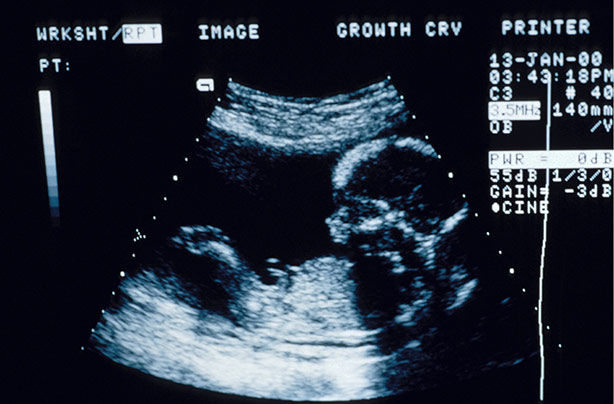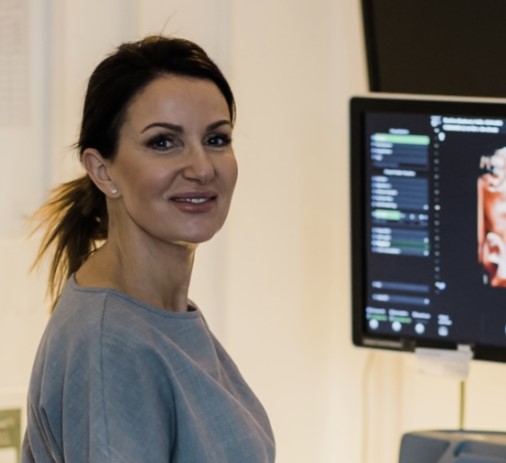Skull theory explained: Can you predict a baby's sex at 12 weeks? Our expert reveals all
Skull theory can be confusing, does it work? We take a closer look at this method of determining whether you're having a girl or boy

The skull theory is a fun gender prediction method, which some claim can determine if you're having a boy or girl from a 12-week ultrasound picture.
Also called the skull gender theory, it joins other techniques like the Nub Theory and ancient Chinese birth chart in trying to guess a baby's sex before the 20-week pregnancy scan. Similar to the Ramzi theory, the skull theory looks at ultrasound images of your baby in the womb, although the two look at different aspects of your baby's development.
"NHS scans are in place for medical purposes," says Amanda Bastianelli a qualified midwife, sonographer and owner of Expectancy Scanning Studios. "At the 20-week scan, the purpose is for anatomy screening. While there might be an opportunity for your sonographer to tell you the sex of your baby based on ‘the potty shot’, this is not the primary purpose of the medical examination. It's not always possible to see the baby's genitalia."
Using your 12-week scan photo, the skull theory looks at your baby's skull shape and size to predict the sex of your baby. But is this just another old wives' tale, or does the skull theory for gender really work? We'll take a look at the scientific evidence. Remember, this test is just for fun, like all baby gender predictor tests before the anatomy scan.
What is skull theory?
The skull theory is centred on an analysis of the cranial differences between males and females. Those who back the skull theory believe that such distinctions are visible in the womb at an early stage of development.
This means that it might be possible to work out whether a baby is male or female by studying the shape of their developing skull in a 12-week scan photo.
How do male and female skulls differ?
Male skulls are more likely to be bigger, heavier and more angular in appearance, while female skulls are thought to be smoother and have less pronounced angles.
Parenting advice, hot topics, best buys and family finance tips delivered straight to your inbox.
The Smithsonian Museum of Natural History observes: "Within the same population, males tend to have larger, more robust bones and joint surfaces, and more bone development at muscle attachment sites."
In terms of weight, male skulls tend to be heavier than those of females because the bones in a man's skull are said to be thicker.
Having said all that, it's incredibly difficult to notice any differences at all between male and female skulls in the womb. Your baby's skull features will not be fully developed at 12 weeks, nor will they be readily distinguishable in a grainy ultrasound picture. Most of the physical differences between male and female skulls happen during puberty when hormones take over.

When it comes to the form or shape of the skull, male foreheads are lower and more sloping. Whereas a female forehead tends to be more vertical.
A comparison of the brow ridge - formally referred to as the 'supraorbital margin' - also yields an interesting observation. For men, this area is curved while for women, it's sharper in appearance.
Below the lower eye ridge is the zygomatic bone. More commonly known as the cheekbone, this tends to be more pronounced on the skull of a male. The same can be said of the superciliary arch, the ridge on the frontal bone above the eye sockets.
Another structural difference can be seen at the lower jawbone. A man's is squared, while a woman's has a rounded appearance.
It's also worth taking a look at the gonion - the point where the bottom of the lower jaw curves upward toward the ear. If it appears to be flared out or sharply angled on the scan, this might be an indicator that you're expecting a boy.
We spoke to Amanda Bastianelli, a qualified midwife, sonographer and owner of Expectancy Scanning Studios, to get her expert take on the idea that you can tell the difference between male and female skulls at this early stage.
"This is sometimes seen on ultrasound, although the earlier the ultrasound is performed, the more limited views are," says Bastianelli. "The skull theory suggests assessing gender differences at around 12 weeks gestation. A fetal head at this age measures in circumference of around 80mm, which you can imagine is quite small to assess any minor visual differences in shape accurately."

Amanda Bastianelli is a qualified midwife, expert sonographer, and business owner of Expectancy Scanning Studios Ltd - a health clinic providing fertility, pregnancy and new parent services, including specialist ultrasound scans, blood tests and pregnancy and baby services.
Amanda has won several awards for her services, including Service Excellence Awards & Businesswoman of the Year 2023 and at the Kent Women in Business Awards.
How accurate is skull theory?
The accuracy is only between 70-95% as reported by the thegenderexperts.com. However, they also point out a lack of scientific research into the Skull theory. "Statistical and quantifiable research on this theory still needs to be scientifically backed."
It's worth noting that no gender prediction method is 100% accurate. Even the Ramzi Theory, which some claim is accurate in up to 97% of cases, isn't going to give you the right answer every time. If you want to know the sex of your baby for certain, you're best waiting for the results from your 20-week scan.
Working out your baby's gender based on the shape of their skull in your 12-week scan might be tricky. This is because, as The Smithsonian points out, the differences between the skulls of boys and girls are only 'subtle' at a young age:
"Sex-related skeletal features are not obvious in children's bones. Subtle differences are detectable but become more defined following puberty and sexual maturation."
In 2015, Scott Donald Haddow from the University of Copenhagen described the reliability of gender prediction methods using skull formation as "dubious" and many other researchers agree that it is impossible to distinguish between male and female skulls until late adolescence - around 18 years of age.
Are there more reliable ways to learn your baby’s sex?
The short answer is yes, there are much more reliable ways to determine your baby's sex during pregnancy than skull theory or other gender prediction methods. However, just one of them is available to all pregnant women in the UK.
- Ultrasound: A medical ultrasound performed by a trained professional is the most accurate non-invasive way to identify your baby's sex. If your scan takes place at around 18 to 20 weeks of pregnancy, you can expect the results to be near 100% accurate.
However, expert midwife and sonographer Amanda Bastianelli has a reminder that the 20-week scan is not for revealing the sex of your baby. "NHS scans are in place for medical purposes," says Amanda. "At the 20-week scan, the purpose is for anatomy screening. While there might be an opportunity for your sonographer to tell you the sex of your baby based on ‘the potty shot’, this is not the primary purpose of the medical examination. It's not always possible to see the baby's genitalia."
Other, more invasive procedures can also reveal the sex of your baby, but this is not their primary purpose. These tests are only offered if you have a higher chance of having a baby with Down's syndrome, Edwards' syndrome or Patau's syndrome.
- Cell-free fetal DNA testing: Also known as NIPT or non-invasive prenatal testing, this blood screening test can tell you your fetal sex by analysing your baby's DNA present in your blood. After 10 weeks of pregnancy, it's almost 100% accurate.
- Amniocentesis: This diagnostic test looks at cells shed by your baby into the amniotic fluid surrounding them. It is nearly 100% accurate in revealing your baby's sex but is invasive and carries a small risk of miscarriage
- Chorionic villus sampling: In this procedure, a small piece of the placenta is removed to reveal chromosomal make-up, including sex chromosomes. It is over 99% accurate but also invasive, with a small risk of miscarriage.
Chat to your midwife about the right choice for you. Only a proper ultrasound after 18 weeks gives a surefire answer. But until then, gender prediction theories are harmless fun!
While you have fun playing the skull theory for gender game, why not discover the differences between raising boys and raising girls? Plus, we have thousands of boy, girl and gender-neutral baby names for you to mull over, from the latest trend for double-barrelled first names to traditional names.
Stephanie has been a journalist since 2008, she is a true dynamo in the world of women's lifestyle and family content. From child development and psychology to delicious recipes, interior inspiration, and fun-packed kids' activities, she covers it all with flair. Whether it's the emotional journey of matrescence, the mental juggling act of being the default parent, or breaking the cycle of parenting patterns, Stephanie knows it inside out backed by her studies in child psychology. Stephanie lives in Kent with her husband and son, Ted. Just keeping on top of school emails/fundraisers/non-uniform days/packed lunches is her second full-time job.